These stickers are being used to improve air quality in so-called environmental zones, which restrict access to certain areas of city centres depending on a vehicle’s emissions standard.
If you’re planning a holiday or business trip to Germany, you need to ensure your vehicle is fitted with the sticker before setting off. Required by law, the cost varies significantly for foreign vehicles depending on where and how you buy them.
Find out more with our latest driving in Europe guide.

Instant cover available
• 24/7 rescue at the roadside
• Help to get home if your vehicle can't be fixed
• 5 star Defaqto rated cover
*T&Cs apply.

What are German emissions stickers or ‘Umweltplakette’?
Every vehicle is assigned a sticker or a 'badge' or ‘Umweltplakette’ according to its emissions standard.
These are part of a three category system, with cars given either a green or yellow sticker that denotes how heavily polluting the vehicle is according to its Euro emissions standard.
Green stickers can be given to vehicles of Euro 5 and above (and electric vehicles). Yellow stickers are issued to Euro 4 emissions standard.
Vehicles with a red emissions sticker are no longer allowed to enter any low-emission zones in Germany. Red stickers are therefore no longer for sale.
However, on scam websites, they are still for sale - so be vigilant when purchasing your sticker!
Euro 1 and pre-Euro diesels, pre-Euro Petrol vehicles and those without a catalytic converter do not qualify for a sticker.
READ MORE: Euro 1 to Euro 7 – find out your vehicle’s emissions standard
Each environmental zone will accept or ban vehicles according to their sticker. Most German cities now only allow cars with a Euro 4 green sticker to enter.
Vehicles that have failed to qualify for any colour of sticker are not permitted to travel within any of Germany’s environmental zones.
Each sticker is only valid for the car in the original application and has a lifetime validity.
Which areas do they affect?
Environmental zones are currently in operation across a growing number of cities and towns across Germany. These already include Berlin, Bonn, Düsseldorf, Hannover, Cologne, Munich and Stuttgart.
Each city has its own designated areas, emission standards and timings so make sure you check the specific area you’re travelling to.
An ‘Umweltzone’ sign signals the start of a zone, with an additional sign to clearly indicate which vehicles are permitted to travel within it.
The sign will indicate which colour sticker a vehicle must have to enter the environmental zone. They feature either a green sticker on its own, a green and yellow sticker, or all three next to the word ‘frei’.
As of the end of 2023, there are low emission zones in more than 70 towns and cities in Germany.

Most newer cars with a catalytic converter will qualify for a green sticker, but if you have a vehicle that’s more than 18 years old, you might want to plan an alternative route that avoids German cities.
The Green-Zones app will tell you where the environmental zones are, what type of sticker you need and where you can order one.
The fine for entering an area where restrictions apply without a vignette is €80.
Please note that the low emission zone in Freiburg will be closed in 2025.
Buy a European Driving Kit from £25.99
Don’t get stung with fines abroad for not having a European Driving Kit
How much do they cost and where do I buy them?
The cost for foreign cars varies depending on where you buy the stickers, so watch out for unofficial commercial sites which tend to sell at inflated prices.
The best - and cheapest - places to apply for your stickers are the official state websites for the area you are travelling to, for example the Berline.de site for driving in Berlin. Stickers here start from €5 - although it does vary depending on the area in Germany.
Please be aware: The ordering process can, in some cases, take up to a few weeks to be delivered, so make sure you leave enough time to order one before you travel.
What happens if I don't buy one?
The law applies to all cars, vans, trucks, and buses but does not apply to motorcycles, tractors and some vintage models.
If you don’t buy a sticker, you’ll be liable to pay an €80 fine plus charges for entering into, stopping or parking in an environmental zone.
An onward journey might also be prohibited.
If you are driving to Germany make sure you read our driving in Germany guide to brush up on other law changes and to find out exactly which documents you need to take with you.
If you're only travelling to Europe for a short period of time, then our single trip European breakdown cover option might be the right choice for you. You may need to arrange temporary car insurance to let a second driver share the driving. And don't forget to think about travel insurance.

Instant cover available
• 24/7 rescue at the roadside
• Help to get home if your vehicle can't be fixed
• 5 Star Defaqto rated cover
*T&Cs apply.











